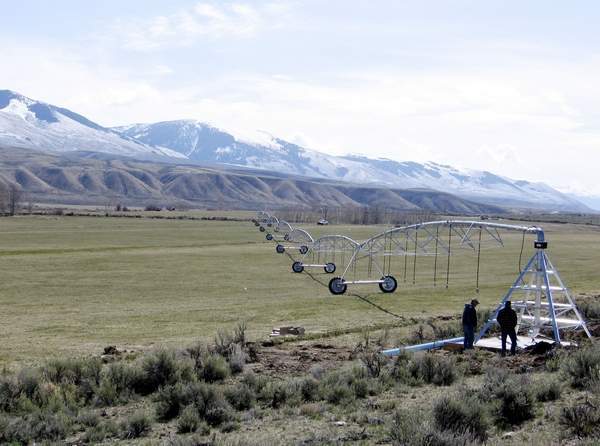forum
library
tutorial
contact

Joint Effort Aids Lemhi River
by Heather Smith ThomasCapital Press, February 7, 2014
|
the film forum library tutorial contact |

|
Joint Effort Aids Lemhi Riverby Heather Smith ThomasCapital Press, February 7, 2014 |
 Irrigation setup is reconfigured and improved to save water from Lemhi River.
Irrigation setup is reconfigured and improved to save water from Lemhi River.
Many of the projects the Lemhi Soil and Water Conservation District takes on benefit anadromous fish -- steelhead and Chinook salmon -- in addition to helping farmers and ranchers more efficiently meet their irrigation needs.
"One we recently did on the upper Lemhi was part of a group of projects done jointly with Trout Unlimited, Nature Conservancy and Idaho Fish and Game," Quinton Snook, project manager for the district in Salmon, Idaho, said. "It made a permanent re-connect in Lemhi Little Springs Creek."
The goal was to divert irrigation water closer to where it is used, eliminating the need for a 7-mile-long irrigation ditch and three irrigation diversions and improving water flows and fish migration.
"The ditch took water out of the river and dumped it into Little Springs Creek to run it down to the field. That long ditch often blew out and filled the river with mud," Snook said.
The field belongs to Tex and Melba Kauer and their McFarland Livestock Co., he said.
"It (previously) took about 20 cubic feet per second to water those fields, and we put in a system that uses less than 2 CFS," he said. "It was a great improvement for the ranch, having pivots for sprinkler irrigation."
Switching to sprinklers kept about 10 CFS of water in the creek year-round, providing cool water for fish.
"In the past it was completely blocked off and fish couldn't get up there," Snook said.
Some projects can utilize a Department of Water Resources program in which the department pays for the power for the pumps for 20 years. This helps the rancher because pumping expenses are high, Snook said.
"This ranch also had a calving corral that was in violation of the Clean Water Act, with cattle drinking out of a spring running through the corral," Snook said. "We had a little money left from the sprinkler project so we put in water troughs and piped the overflow out of the corral."
Tex Kauer said the change to sprinkler irrigation has helped his ranch.
"It's more expensive to irrigate than what we thought, but we've been able to increase production from those fields, and there's less water loss," he said.
"This project eliminated several miles of ditch. We lost a lot of water in that ditch, and it also took a lot of maintenance. Now we don't have to worry about that," Kauer said. "Instead, we have maintenance on the sprinkler system. So far it's been about an equal trade-off, and less labor involved in irrigation."
The new watering system at the calving corrals is working nicely, he said.
"The excess runs out without going through manure," he said. "This made a better drinking facility for the cattle, and the ducks and geese also enjoy that corral!"
learn more on topics covered in the film
see the video
read the script
learn the songs
discussion forum
